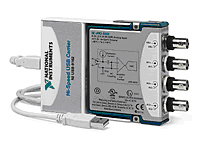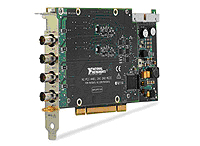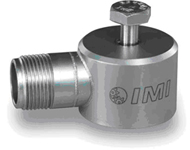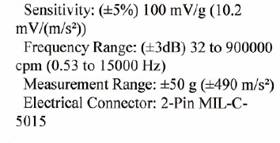VIBRATIONS AND NOISE MEASUREMENTS MODULE
The module has several components for measuring, acquire and process noises and vibrations of diferent electrical machines and equipments.
NI USB 9233 24-bit, 50 ks/s, 4-input usb dynamic signal acquisition
 |
|
|---|---|
|
|
Overview
The National Instruments USB-9233 is a four-channel dynamic signal acquisition module for making high-accuracy measurements from IEPE sensors. The NI USB-9233 delivers 102 dB of dynamic range and incorporates IEPE signal conditioning for accelerometers and microphones. The four USB-9233 input channels simultaneously acquire at rates from 2 to 50 kHz. In addition, the module includes built-in antialiasing filters that automatically adjust to your sampling rate.
Hardware
Data rates on the four simultaneous input channels of the USB-9233 range from 2 to 50 kHz. Each signal is AC coupled, buffered, analog prefiltered, and sampled by a 24-bit delta-sigma analog-to-digital converter (ADC) that performs digital filtering with a cutoff frequency that automatically adjusts to your data rate. The USB-9233 module features a voltage range of ±5 V and a dynamic range of over 100 dB. Communication to the USB-9233 is Hi-Speed USB 2.0, guaranteeing data throughput. The USB-9233 is a nonisolated module that provides ±30 V of overvoltage protection (with respect to chassis ground) for IEPE sensor connections. IEPE excitation and AC coupling are not software-selectable and are always enabled. The USB-9233 uses a method of A/D conversion known as deltasigma modulation. If the data rate is 25 kS/s, each ADC actually samples its input signal at 3.2 MS/s (128 times the data rate) and produces samples that are applied to a digital filter. This filter then expands the data to 24 bits, rejects signal components greater than 12.5 kHz (the Nyquist frequency), and then digitally resamples the data at the chosen data rate of 25 kS/s. This combination of analog and digital filtering provides an accurate representation of desirable signals while rejecting out-of-band signals. The built-in filters automatically adjust themselves to discriminate between signals based on the frequency range, or bandwidth, of the signal.
Software
The USB-9233 uses NI-DAQmx as the hardware and OS interface, so you can build automated test systems or integrate the USB-9233 with other hardware, including National Instruments multifunction DAQ products and CAN devices, through NI-DAQmx function calls for NI LabVIEW, LabWindows/CVI, and Measurement Studio.
Other useful NI-DAQ driver software features include:
• Automatic Code Generation – DAQ Assistant is an interactive guide that steps you through configuring, testing, and programming measurement tasks and automatically generates the necessary code for LabVIEW, LabWindows/CVI, or Measurement Studio. • Test Panels – With NI-DAQ, you can test all of your device functionality before you begin application development.
• LabVIEW Integration – All NI-DAQ functions use the waveform data type, which carries acquired data and timing information directly into more than 400 LabVIEW built-in analysis routines for display of results in engineering units on a graph.
Analysis Software
Because of its bandwidth, the USB-9233 is well-suited for applications in noise and vibration analysis. These applications are specifically addressed in the LabVIEW Sound and Vibration and LabVIEW Order Analysis toolkits. By using these toolkits in conjunction with a USB-9233
module, you can produce power spectra, frequency responses, fractionaloctave analysis, sound-level measurements, order spectra, order maps, order extraction, and sensor calibration. The USB-9233 is ideal for a wide variety of mobile/portable applications such as industrial machine condition monitoring and in-vehicle noise, vibration, and harshness testing.
NI PCI-4462 24-Bit, 204.8 kS/s, 4 Inputs
 |
2 or 4 simultaneously sampled analog inputs • 2 simultaneously updated analog outputs (NI 4461 only) • 118 dB dynamic range, 24-bit resolution • 204.8 kS/s maximum sampling rate • 92 kHz alias-free bandwidth • Input range from ±316 mV to 42.4 V • 6 gain settings • AC/DC coupling • Antialiasing and anti-imaging protection • IEPE conditioning – software-configurable • Multimodule synchronization |
|---|---|
Overview
The National Instruments 4461 and 4462 are high-accuracy data acquisition devices specifically designed for sound and vibration applications. The devices include the hardware and software needed to make precision measurements with microphones, accelerometers, and other transducers that have very large dynamic ranges. Common applications for the NI 446x include audio test, automotive test, noise, vibration, and harshness (NVH) analysis, and machine condition monitoring (MCM). The NI 446x devices offer a complete range of functionality for sound and vibration monitoring and analysis applications. With either two inputs and two outputs, or four inputs, they are ideal for applications where simultaneous generation and acquisition of noise, vibration, and acoustic signals are required. You can synchronize the acquisition clock of your NI 446x with other instruments in your system for mixed-signal applications. Both analog and digital triggering are available on an NI 446x.
Hardware - Applications
• Audio Test
• Noise, Vibration, and Harshness Test
• Machine Condition Monitoring
• Sound Power
• Structural Vibration
• Pass-by Noise
Analog Inputs
The analog input channels of NI 446x devices have 24-bit resolution ADCs that are simultaneously sampled at software-programmable rates for standard audio applications, such as 44.1 kS/s (the standard rate used in CD players), 48.0 kS/s (the rate used in digital audio tape (DAT) recorders and other digital audio equipment), 96.0 kS/s, and 192 kS/s. An NI 446x is well-suited for audio, sound, and vibration analysis applications. The analog inputs offer programmable AC/DC coupling. A programmable gain amplifier stage on the inputs gives gain selection from -20 to +30 dB in 10 dB steps. Furthermore, to provide you with the quietest and highest-quality analog measurements, the input stage accepts differential or single-ended signal connections.
• Operating Systems
• Windows 2000/NT/XP
NI MID-7604
 |
4-axis stepper power drive, 1.4 A per axis |
|---|---|
4-axis stepper power drive, 1.4 A per axis
Front panel configuration
CE certified
User-selectable microstepping
Power supply, driver, heat sink, and cooling
Host PC bus power monitoring/shutdown
Overview and Applications
The National Instruments MID-760x integrated stepper motor power drives and MID-765x integrated DC-brush servo motor power drives offer reliable, easy-to-connect drive solutions for National Instruments motion controllers. The NI MID-760x provides stepper motor control from the NI 7330, 7340, and 7350 controllers. The MID-7650 provides DC-brush servo motor control from NI 7340 and 7350 controllers. Because the MID-760x and the MID 7650 have all the required motion drive and motion I/O signals, they offer all the features of a universal motion interface wiring module with the enhancements of a powered motor drive in a single product. The NI MID power drives connect to motion controller boards through a single-shielded cable that transfers all motor commands, as well as motion I/O control and feedback signals.
The MID-7604 and MID-7602 are 4-axis and 2-axis stepper motor drive units, respectively. The MID-7654 and MID-7652 are 4-axis and 2-axis DC-brush servo motor drive units, respectively. These compact, well integrated drives incorporate per-axis amplifiers, motor-power DC bus supplies, low-voltage motion I/O supplies, and pluggable screw terminal connectivity in a single rugged metal enclosure. This optimized system wiring design simplifies motion component selection.
High-Efficiency Architecture
The MID-760x power drives incorporate an efficient bipolar chopper architecture that converts step and direction control signals into winding currents for 2-phase stepper motors. The MID-765x power drives incorporate an efficient servo amplifier architecture that converts analog control signals into winding currents for DC-brush motors. The pulse width modulation driver technology in the MID-765x accurately controls motor winding current, while reducing motor heating, lowering ripple current, and improving overall motor performance. Active fan cooling provides optimal motion power drive operation.
ACCELEROMETER 645A01.
 |
|
|---|---|
